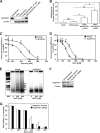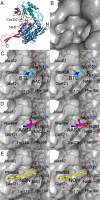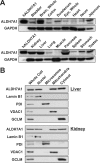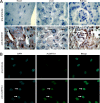Aldehyde dehydrogenase 7A1 (ALDH7A1) is a novel enzyme involved in cellular defense against hyperosmotic stress
- PMID: 20207735
- PMCID: PMC2881771
- DOI: 10.1074/jbc.M109.077925
Aldehyde dehydrogenase 7A1 (ALDH7A1) is a novel enzyme involved in cellular defense against hyperosmotic stress
Abstract
Mammalian ALDH7A1 is homologous to plant ALDH7B1, an enzyme that protects against various forms of stress, such as salinity, dehydration, and osmotic stress. It is known that mutations in the human ALDH7A1 gene cause pyridoxine-dependent and folic acid-responsive seizures. Herein, we show for the first time that human ALDH7A1 protects against hyperosmotic stress by generating osmolytes and metabolizing toxic aldehydes. Human ALDH7A1 expression in Chinese hamster ovary cells attenuated osmotic stress-induced apoptosis caused by increased extracellular concentrations of sucrose or sodium chloride. Purified recombinant ALDH7A1 efficiently metabolized a number of aldehyde substrates, including the osmolyte precursor, betaine aldehyde, lipid peroxidation-derived aldehydes, and the intermediate lysine degradation product, alpha-aminoadipic semialdehyde. The crystal structure for ALDH7A1 supports the enzyme's substrate specificities. Tissue distribution studies in mice showed the highest expression of ALDH7A1 protein in liver, kidney, and brain, followed by pancreas and testes. ALDH7A1 protein was found in the cytosol, nucleus, and mitochondria, making it unique among the aldehyde dehydrogenase enzymes. Analysis of human and mouse cDNA sequences revealed mitochondrial and cytosolic transcripts that are differentially expressed in a tissue-specific manner in mice. In conclusion, ALDH7A1 is a novel aldehyde dehydrogenase expressed in multiple subcellular compartments that protects against hyperosmotic stress by generating osmolytes and metabolizing toxic aldehydes.
Figures






Similar articles
-
Aldehyde dehydrogenase 7A1 (ALDH7A1) attenuates reactive aldehyde and oxidative stress induced cytotoxicity.Chem Biol Interact. 2011 May 30;191(1-3):269-77. doi: 10.1016/j.cbi.2011.02.016. Epub 2011 Feb 19. Chem Biol Interact. 2011. PMID: 21338592 Free PMC article.
-
Structural and biochemical consequences of pyridoxine-dependent epilepsy mutations that target the aldehyde binding site of aldehyde dehydrogenase ALDH7A1.FEBS J. 2020 Jan;287(1):173-189. doi: 10.1111/febs.14997. Epub 2019 Jul 25. FEBS J. 2020. PMID: 31302938 Free PMC article.
-
Structural Basis of Substrate Recognition by Aldehyde Dehydrogenase 7A1.Biochemistry. 2015 Sep 8;54(35):5513-22. doi: 10.1021/acs.biochem.5b00754. Epub 2015 Aug 19. Biochemistry. 2015. PMID: 26260980 Free PMC article.
-
Consensus guidelines for the diagnosis and management of pyridoxine-dependent epilepsy due to α-aminoadipic semialdehyde dehydrogenase deficiency.J Inherit Metab Dis. 2021 Jan;44(1):178-192. doi: 10.1002/jimd.12332. Epub 2020 Dec 1. J Inherit Metab Dis. 2021. PMID: 33200442
-
Aldehyde dehydrogenases and cell proliferation.Free Radic Biol Med. 2012 Feb 15;52(4):735-46. doi: 10.1016/j.freeradbiomed.2011.11.033. Epub 2011 Dec 21. Free Radic Biol Med. 2012. PMID: 22206977 Review.
Cited by
-
Inhibition, crystal structures, and in-solution oligomeric structure of aldehyde dehydrogenase 9A1.Arch Biochem Biophys. 2020 Sep 30;691:108477. doi: 10.1016/j.abb.2020.108477. Epub 2020 Jul 24. Arch Biochem Biophys. 2020. PMID: 32717224 Free PMC article.
-
Quantitative Proteomics and Network Analysis of Differentially Expressed Proteins in Proteomes of Icefish Muscle Mitochondria Compared with Closely Related Red-Blooded Species.Biology (Basel). 2022 Jul 26;11(8):1118. doi: 10.3390/biology11081118. Biology (Basel). 2022. PMID: 35892974 Free PMC article.
-
Pyridoxine-dependent epilepsy (PDE-ALDH7A1) in adulthood: A Dutch pilot study exploring clinical and patient-reported outcomes.Mol Genet Metab Rep. 2022 Mar 4;31:100853. doi: 10.1016/j.ymgmr.2022.100853. eCollection 2022 Jun. Mol Genet Metab Rep. 2022. PMID: 35782612 Free PMC article.
-
Molecular evidence of the toxic effects of diatom diets on gene expression patterns in copepods.PLoS One. 2011;6(10):e26850. doi: 10.1371/journal.pone.0026850. Epub 2011 Oct 28. PLoS One. 2011. PMID: 22046381 Free PMC article.
-
Genomic loci modulating retinal ganglion cell death following elevated IOP in the mouse.Exp Eye Res. 2018 Apr;169:61-67. doi: 10.1016/j.exer.2017.12.013. Epub 2018 Feb 3. Exp Eye Res. 2018. PMID: 29421330 Free PMC article.
References
-
- Lee P., Kuhl W., Gelbart T., Kamimura T., West C., Beutler E. (1994) Genomics 21, 371–378 - PubMed
-
- Malik H. S., Henikoff S. (2003) Nat. Struct. Biol. 10, 882–891 - PubMed
-
- Guerrero F. D., Jones J. T., Mullet J. E. (1990) Plant Mol. Biol. 15, 11–26 - PubMed
-
- Stroeher V. L., Boothe J. G., Good A. G. (1995) Plant Mol. Biol. 27, 541–551 - PubMed
Publication types
MeSH terms
Substances
Associated data
- Actions
Grants and funding
LinkOut - more resources
Full Text Sources
Molecular Biology Databases
Miscellaneous

